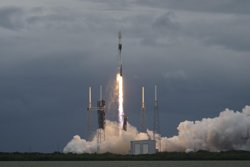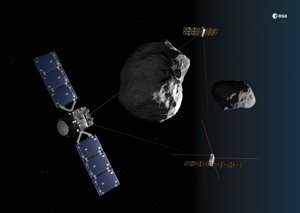Successful launch of European Hera mission: Dutch high-tech examines damaged space rock
Can space technology protect us if an asteroid is on a collision course with Earth? That is one of the questions that ESA's new space mission Hera must answer. The space probe, packed with Dutch technology, was successfully launched on Monday, October 7.
© ESA
The chance that a large space rock will come straight to Earth is not very high, but it is not zero either. Just think of the dinosaurs, which became extinct 66 million years ago after a meteorite impact at Chicxulub in Yucatán, Mexico.
Three quarters of all life on Earth did not survive the consequences of that impact. To prevent humans from having to experience something similar, space organizations are investing in planetary defense – the protection of our planet.
Hera was launched into space on a Falcon 9 rocket from Florida on October 7 at 4:52 PM Dutch time. In February 2026, the satellite will arrive at asteroid Didymos and its moon Dimorphos. Then research into the impact of NASA's DART mission will begin in September 2022.
Exciting quest
More than two years ago, the American space mission DART deliberately hit the small celestial body Dimorphos, a moon of the asteroid Didymos, with a 'wrecking ball'. It was a test to see if Dimorphos' trajectory would bend. And that seems to have worked.
Now it is the turn of ESA's Hera spacecraft to investigate the consequences of that collision. How exactly has Dimorphos' orbit changed? What does the space rock look like inside? And can we apply DART's method if Earth is threatened by space debris?
It is an exciting quest, in which Dutch space companies are also involved. Cosine supplied the sensor that will measure the composition of Dimorphos. Isispace a system to launch two small cubesats from Hera. And Bradford built sun sensors for navigation.
Learning satellite
“It is a complex mission,” says Michel van Pelt of ESA. 'With Hera, we will be able to see the inside of an asteroid for the first time in history, thanks to the crater that DART made there. Because we don't know what the conditions are like on site, we approach Hera in steps. Hera is learning to operate more and more autonomously, a bit like a self-driving car.'
Van Pelt compares the Hera mission with a medical examination. Dart wounded Dimorphos with an impact. Now it is up to Hera to make a very accurate diagnosis, so that we can learn from it. The mission ends with a 'kiss on the wound', when Hera makes a soft landing.
Two million pixels
One of the instruments on board Hera is a modified version of the Dutch space instrument Hyperscout, developed by Cosine from Warmond. This multispectral camera with two million pixels measures the condition of Dimorphos in fifty different wavelengths.
Nathan Vercruyssen of Cosine: 'Hyperscout was developed to investigate floods and forest fires here on earth. We have significantly modified the design for this deep space mission, includ
HERA and CubeSat connected with inter-satellite links © ESA-Science Office
ing a new camera and protection against extremely low temperatures and cosmic radiation.'
Small satellite company Isispace from Leiden is also involved in the mission. It built a special 'Deep Space Deployer' for the launch of two cubesats. 'This launch mechanism protects the cubesats on their way to the asteroid. He can launch them on site very quietly, like a jack of all trades, without any negative consequences for the mothership Hera,' explains Jeroen Rotteveel of Isispace.
Participating in the Hera mission is interesting for the Delft company, says Rotteveel, because it can develop and qualify an innovative product in space. A product that can also transport cubesats to the moon and Mars in the future. “It allows us to gain a position in other space programs worldwide.”
Space travel connects
Anyone who looks at the technology for Hera will be amazed at how small it all is. But it contributes to research into a very large and important subject, says Joanna Ruiter of the NSO: 'The threat from space is real. In 2013, a thousand people were injured in Russia when a piece of space debris struck there. And that was from a relatively small meteorite. Imagine what happens when an asteroid with a diameter of several kilometers comes towards Earth.'
Hera increases our knowledge of asteroids and what we can do to deflect them before they impact Earth. The mission is a collaboration between eighteen European countries and more than a hundred companies, all with their own specific knowledge and experience. Ruiter: 'You see: space travel connects. A mission like Hera is so difficult, so groundbreaking, that you all have to work together to make it happen.'
Dutch technology, on a European satellite, that serves humanity.